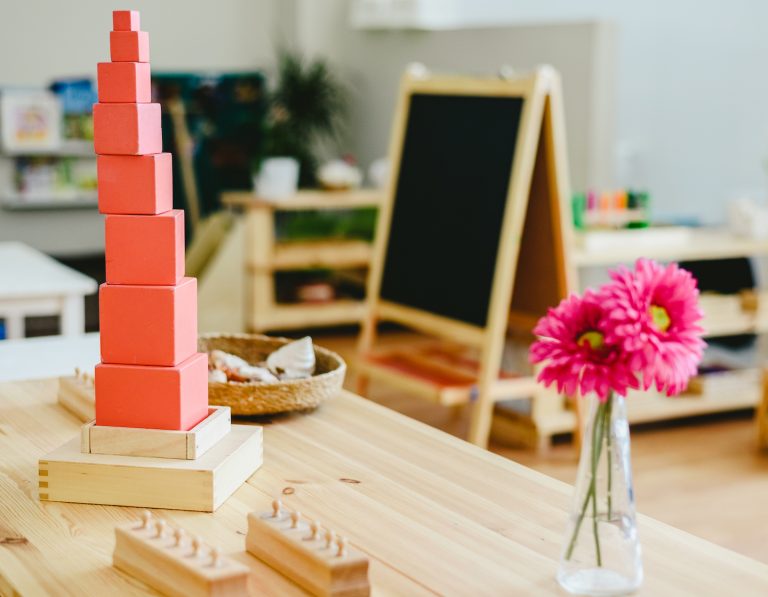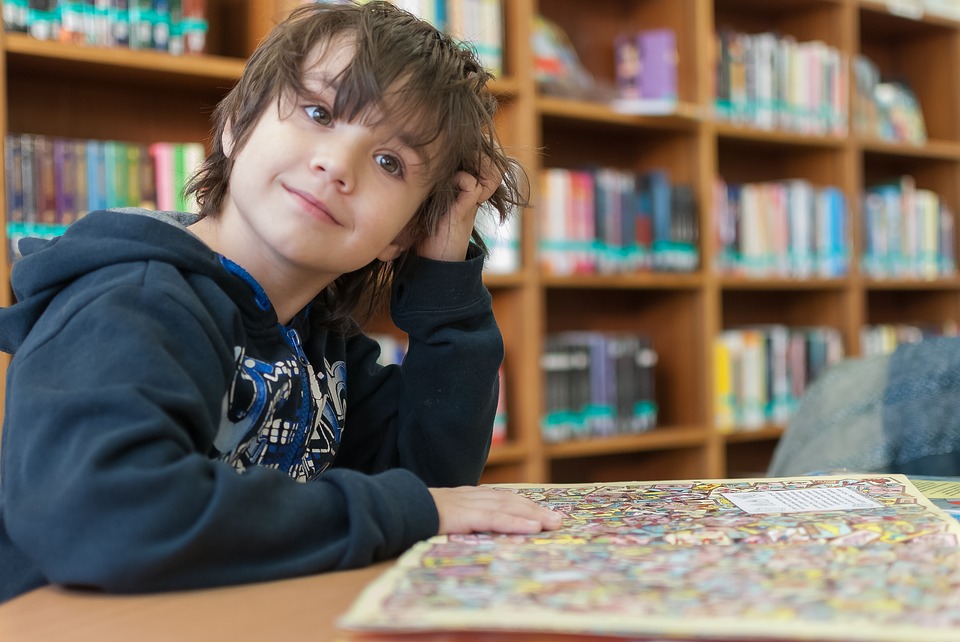
Exploring other options of education as your toddler grows up? This article explains a new(ish) method of teaching that is steadily growing in popularity as more parents learn about it.
This method is a stark contrast from the traditional ‘cookie cutter’ style of teaching we have seen over the decades from our factory style school system.
Also, you may want to check out the 5 Benefits of Delaying Preschool According to Science.
Over the past decade, we have seen a veritable explosion of new and old pedagogy and education development as parents have had both the need for more individualized education as well as the desire for greater personal growth (which has a variety of definitions) for their children alongside traditional academic development.
So what IS Montessori?
Montessori is the namesake method of teaching/pedagogy, founded in 1907 by Dr. Maria Montessori (also the first woman in Italy to become a physician, her legacy is very strong!).
In her research of child development and education, she found that “in an environment where children are allowed to choose their work and to concentrate for as long as needed on that task, they came out of this period of concentration refreshed and full of good will toward others” (As defined by the American Montessori Association).
Put another way, this method is geared toward the result of a focused, energized, and socially aware and engaged child.
Starting to see why this might be an increasingly popular choice? It achieves the exact opposite of today’s public education, and even traditional competitive private education, climate in most places- where we see children stressed starting in preschool, seemingly “unable” to focus, and beyond socially inept (with a rise of bullying, suicide, and school shootings).
These are never things parents would choose for their children! And instead of focusing on how we got here, or projecting fearful numbers as to their growth trajectory, there’s a big movement of committed parents, teachers, community leaders, etc. actively creating and growing alternatives.
Hence, we also see charter schools and home schools growing. Home schooling is particularly strong, going from 1300 in 1970 to 2.3 million children in 2016; and home schooling has a lot of the same intentions (building independence, one-one teaching methods, engaging with sensory materials instead of sitting at desks, etc.) as Montessori.
There are now over 4,000 certified Montessori schools in the U.S. and it is available to children from preschool through grade 12. It is a “full program” in that sense, though students from diverse backgrounds are welcomed.
What’s also interesting is that there are over 200 public Montessori’s available, and many of the private Montessori’s offer financial aid in various forms from monetary endowments to parent co-op’s and will cover partial or full tuition, so don’t be afraid to inquire as you would any private school!

What do Montessori students do?
When a Montessori student enters their classroom, they prepare for the day (depends on the classroom, some teachers begin with a song, a prayer, discussion of overall goals for the day/week, etc.), and then go into a three hour work period.
For children under age six, this is an uninterrupted time. For children ages six and up, there will be time in the three hours for a teacher to give small group (3-6 children out of a full classroom of 30) lessons and do individual check-ins along with the teacher’s assistant.
The classrooms are mixed age (based on developmental readiness with a class for ages 0-3, 3-6, 6-9, 9-12, 12-15, and 15-18) and each classroom is set up with the range of readiness in mind.
There are no rows of desks and chairs, yet everything is orderly. Even the youngest, ages 0-3, know where each material belongs, where to find it for their work, and how to put it back (and usually if they neglect this their peers remind them before the teachers do- which puts the context of learning back on that social awareness end rather than hierarchical/disciplinarian end).
Classrooms for smaller children are set up with the height/size of smaller children in mind so that they can grasp everything (you’ll note several sizes of the abacus- used for learning counting in the preschool classrooms and mathematical calculations in elementary classrooms).
Curiosity is inspired by the “free movement” that happens while students are individually constructing their projects. They will notice what their peers are doing and ask, or spontaneously share what they are doing with their peers.
Learning the appropriate timing of these behaviors is a major objective for children ages 0-9 and they will be reminded by their peers and teachers when it is a good time to discuss or collaborate and when it is a good time to work independently.
This is extraordinarily helpful for students with learning disabilities who may have trouble focusing, as they are free to ask for help as they need it and are reminded more frequently by their peers rather than an authority figure about how to “do” the process of learning in their own way (though teachers can and will step in to keep the energy flowing in a productive direction, sometimes asking “What did you have a question about?” or something similar to engage the “disturber”) .
Students are encouraged to troubleshoot with each other by making suggestions based on their interactions rather than being separated, scolded, or told they are “special” based on their academic performance (and subsequent comparison of their academic performance to an invisible standard).
Aside from classroom subjects, a Montessori student is responsible for the entire class and school environment: caring for themselves (e.g. proper hygiene), looking after their environment (e.g. cleaning up- older students especially form groups and decide who is responsible for cleaning what, such as taking the trash out, inspecting bathrooms, sweeping, etc.), helping each other (e.g. cooking), gardening, speaking directly but always respectfully, being aware of how much space to use for a project and allowing others to share the space, moving slowly through the projects/work of others. And as students get older, contributing to work in the community.
These lessons are equally as important in development as academic ones, and Montessori students do not miss out on them!
Independent research and peer groups are both important to and inherent to the Montessori method.
Children starting around (sometimes older) age 6 do independent research of their own design (with teacher oversight so there are measurable goals/outcomes).
They put together field trips (yes, they do this all on their own, again with teacher oversight so certain necessities are not missed).
They create presentations both individual and group, put on art exhibits or plays/musicals, perform and display science projects, etc.
What Montessori teachers are like..
A word about Montessori teachers. Their training is highly specialized and requires passing tests, both written and oral, not just on the lessons that will be taught but also on proper assessment of a child’s development according to their age, ability, and interest in lessons.
The Montessori teacher is trained not just to give lessons and explain knowledge to students in the context of the entire classroom- but to actively participate in and be attentive to the individual child’s needs.
Because classrooms are mixed age, this provides adequate time for students to develop their interests first, but also exit the class with knowledge in areas that otherwise do not interest them. The Montessori teacher guides this process and has the benefit of being able to do this over the course of several years based on a child’s readiness rather than several months based on pre-assigned standards.
In their training, Montessori teachers are also taught how to best communicate with each learning style (of which there are so many: musical, bodily-kinesthetic, spatial, inter or intrapersonal, intuitive, and traditional reading/writing/‘rithmatic).
Teachers who have this ability, Montessori or not, are successful in conveying material to their students as per Harvard psychologist Howard Gardner’s theory of multiple intelligences.
What do Montessori students NOT do?
The short answer is: a lot of things! Textbooks? Nope. Testing? Also nope.
Notably absent in most Montessori classrooms is an abundance of technology. There are typically one or two computers or tablets available and their usage is not discouraged, especially for older children (in the preschool classrooms these technologies are not used, though an occasional film may be shown on a conventional television) whose projects are advanced and they are able to use a wide range of methods/resources available online and offline.
Also notably absent is a letter grade system or any form of reward/punishment.
Instead, students (even the youngest) compile a portfolio and achieve passage based on developmental readiness.
This is assessed by the teacher and assistant teacher in correspondence with other Montessori faculty if necessary.
Once students are six (and until they are eighteen), their portfolios consist of contracts created with teachers.
This may cause a little skepticism; but the fact is, creating a level of responsibility for their own work a) inspires learning and b) allows for an unusual level of focus.
The result? “The work of the 6-9 class includes subjects usually not introduced until high school or college.”
For the little ones, a big “absence” is pretend play. The very simple reasoning you won’t find pretend play happening in the preschool and kindergarten aged children is that when offered in the first decade of Montessori school development, none of the children chose it. Instead, they favored kitchen/cooking play/work, as well as building, painting, reading, cleaning, gardening, etc.
In the end, how we educate our children matters, especially between the ages of 0-10!
The Montessori children learn about life in schools that are life-like.
No matter what choices you make for your child’s education, the more you know, the better they will be!
